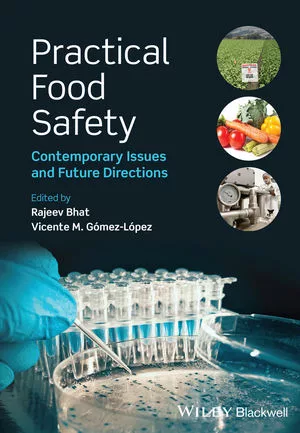The Future of Food Safety for the Foodservice Industry

The 1980s and 1990s were a challenging period for the U.S. restaurant and foodservice industry, marked by the evolution and globalization of food supply chains; increased regulatory oversight to control Escherichia coli O157:H7, Listeria monocytogenes, Salmonella and other potentially deadly foodborne pathogens; increased media attention on foodborne illness outbreaks; and heightened consumer activism for safe and quality food.
The era was rife with complex and perplexing issues for industry stakeholders, serving as the impetus behind the evolution of new principles, such as active managerial controls; advanced technologies (i.e., automated handwashing systems for food handlers); and science-based practices (e.g., robust cleaning and sanitizing of food contact surfaces).
It is thus an opportune time to explore the future of food safety in the restaurant and foodservice industry and what lies ahead—by extension—for its supply chain partners.
Foodborne Illness Inroads
As the nation’s second largest private sector employer—estimated at 14.7 million workers—and with over 130 million meals sold daily,[1] the restaurant and foodservice industry is committed to protecting consumers by making significant inroads against foodborne illness.
Annually, the U.S. Centers for Disease Control and Prevention (CDC) estimates that one in six Americans (or 48 million people) get sick, 128,000 are hospitalized and 3,000 die of foodborne diseases.[2] A 2013 U.S. Department of Agriculture Economic Research Services report placed the economic impact caused by foodborne pathogens at $15.5 billion yearly.[3]
Operations, both large and small, face a myriad of supply chain management challenges, regulatory reckonings and compliance activities, such as local health inspections, to maintain and improve food safety. Going forward, restaurants and foodservice establishments must:
• Support risk management initiatives from farm to fork
• Monitor suppliers to ensure they comply with Food Safety Modernization Act (FSMA) regulations
• Adhere to U.S. Food and Drug Administration (FDA) Food Code provisions designed to prevent foodborne illness and outbreaks associated with restaurants and other retail foodservice establishments
• Foster stronger and transparent relationships with suppliers
• Leverage advanced technologies in the workplace
• Support food safety standards in accordance with the Global Food Safety Initiative (GFSI)
• Further its commitment to food handler training program
Prodigious Impact
FSMA, the sweeping legislation enacted in 2011 under the Obama administration, places a significant premium on prevention in several rules designed to control contamination in the country’s food supply from farm to fork.[4] While the impact of FSMA on the restaurant and foodservice industry is largely deemed as minimal, its ramifications on suppliers are mighty.
Robert L. Garfield, senior vice president of the Safe Quality Food Institute (SQFI), says the implementation of the prodigious law has been especially trying for small and very small companies which deal with “tight financial bottom lines” on a daily basis.
The SQFI executive notes that small producers hoping to capitalize on promising market opportunities, such as local sourcing, can find themselves under intense duress when “something like the FSMA produce rule comes along.”
“All of a sudden they are required to do things that they do not have the understanding, money or staff to do,” Garfield says.
Small producers, manufacturers and distributors generally do not have an overabundance of resources like their larger counterparts to comply with hordes of local, state and federal requirements. But they must persevere to sustain partnerships with their customers.
“Food operators and retailers are going to start insisting that the products that come into their establishments are as safe as they can be,” Garfield states. Consequently, he notes, suppliers are “going to have to step up and do the things that are necessary to help ensure the protection of their brands.”
In speaking with FSMA challenged companies, Garfield is encouraged that some are taking proactive steps, such as pursuing GFSI certification, to better navigate the many contours of FSMA, but others—unfortunately—are adrift. SQFI, which is administered by the Food Marketing Institute, has created guidance programs for smaller companies which are having a rough time gripping the intricacies of FSMA.
In a related vein, restaurant and foodservice establishments are urged to forge stronger relationships with suppliers. On-site risk-based inspections can be particularly beneficial in helping suppliers understand and comply with FSMA mandated practices and procedures.
Integrated Food Safety System
FSMA is the reigning 800-pound gorilla in the food industry, but Joseph Corby, Executive Director of the Association of Food and Drug Officials (AFDO), believes the time is ripe to achieve a long discussed regulatory objective: an Integrated Food Safety System (IFSS).
In 1998, AFDO—an international, non-profit organization dedicated to streamlining and simplifying regulations—was the first U.S. group to advocate the creation of an IFSS that would empower state and local authorities to collaborate effectively with federal agencies.
Under a joined alliance, IFSS strategic partners—with input from food industry stakeholders—would:
• Implement and use data from foodborne illness and outbreak surveillance for evidence-based food safety policies and programs, and evaluate their effectiveness
• Implement efficient, prevention-focused, risk-based inspections
• Plan and prioritize work to coordinate resources
• Promote use of compliance and enforcement tools for achieving compliance with food safety laws and regulations
• Share foodborne illness data among strategic partners
• Promote use of compliance and enforcement tools for achieving compliance with food safety laws and regulations[5]
With the implementation of FSMA, Corby, who has led AFDO for 9 years, says many facets of an “integrated food safety system are in place,” moving IFSS from a vision born two-decades ago to a reality in the not too distant future.
“In FSMA, there is a mandate that FDA better coordinates with its state and local partners to achieve an IFSS,” he explains.
Consolidated IFSS data will someday make it possible for industry stakeholders to gain a better understanding of the causes behind restaurant/foodservice related foodborne illness outbreaks and drive the development of prevention practices.
Noting foodborne illness incidences are decreasing nationwide, Corby is bullish on the future of food safety. His optimism is fueled by a number of factors; one in particular is the evolution of whole genome sequencing (WGS) technology, which has been utilized by the FDA since 2008 to isolate and understand the source of foodborne illness outbreaks.
In addition to determining the source of a foodborne illness outbreak with great speed and precision, the federal agency is employing WGS technology to:
• Ascertain which illnesses are part of an outbreak and which are not
• Determine which ingredient in a multi-ingredient food is responsible for the outbreak
• Differentiate sources of contamination, even within the same outbreak
• Link small numbers of illnesses, including geographically diverse illnesses occurring across multiple states, that might not otherwise have been identified as a common outbreak[6]
From a scientific perspective, WGS is in its infancy. The continued development of this cutting-edge technology has the potential to yield a host of food safety improvements in the future.[7]
Fab Technology
Like Lennon and McCartney, the “future” and “technology” are conjoined in popular culture making it virtually impossible to discuss one without the other.
The food industry has long embraced futuristic, science-based technology to improve and advance product safety. Over the past several years, groundbreaking innovations ranging from novel packaging to advanced electronic tracking systems have propelled food safety.
A number of 21st century advances, such as wearable technology glasses (for virtual auditing and training), predictive analytics (to forecast major food safety risks), and mobile capture technology (to manage integrated assessments), are gaining traction in the restaurant and foodservice industry.
The exponential potential of these innovations, which have been applied in various business sectors, is still to be realized, but their ultimate influence is expected to be far reaching.
Safety in Every Meal
By 2026, jobs combining food preparation and service are expected to spike by 15 percent (a gain of 504,000 positions) in the restaurant and foodservice industry.[8] This anticipated growth magnifies the importance of having trained and skilled food handlers.
Stating “consumers expect safety in every meal they buy,” Cindy Jiang, director of global food safety & supply chain compliance for McDonald’s, says proper training and education in the workplace are instrumental in ensuring patron expectations are met.
The CDC and FDA commonly cite five factors—food from unsafe sources, inadequate cooking, improper holding temperatures, contaminated equipment and poor personal hygiene—as leading causes of foodborne illness outbreaks in retail and food service establishments.
Jiang, a leading food safety training proponent, states operations should leverage training from reputable providers to help food handlers grasp proper safety procedures and achieve measureable organizational goals. Management teams, she adds, must be consistent in monitoring personnel to ensure they comply with safety protocols.
Overall, the restaurant and food service industry is doing a good job in communicating its efforts to improve food safety to consumers through educational outreach initiatives, according to Jiang, but there is room for improvement.
“It’s a challenge, but we can do a better job of communicating our message to consumers,” she says.
Industry stakeholders are urged to utilize various communication channels, such as websites, blogs, social media and traditional public relations vehicles, to broadcast its food safety agenda to consumers.
More Precious than Gold
Other than water, no natural commodity—not silver, not gold, nor platinum—is a more important to human survival than safe, nutritious and quality foods. The World Health Organization, a leading global health advocacy group, attests to this socioeconomic truth.
Food safety is an ingrained part of our daily existence. Looking ahead, the restaurant and foodservice industry faces an extensive safety checklist, but is well equipped through a plethora of scientific tools, technologies and advances to mark every box.
For more information on the National Registry for Food Safety Professionals, visit www.nrfsp.com/.
References
1. https://edubirdie.com/blog/report-measures-pandemics-effect-on-business.
2. www.cdc.gov/foodborneburden/2011-foodborne-estimates.html.
3. www.ers.usda.gov/webdocs/publications/43984/52807_eib140.pdf?.
4. www.fda.gov/Food/GuidanceRegulation/FSMA/ucm242500.htm.
5. www.fda.gov/downloads/ForFederalStateandLocalOfficials/ProgramsInitiatives/PartnershipforFoodProtectionPFP/UCM408081.pdf.
6. www.fda.gov/ForConsumers/ConsumerUpdates/ucm507501.htm.
7. www.food-safety.com/magazine-archive1/junejuly-2015/use-of-whole-genome-sequencing-in-food-safety/.
8. National Restaurant Association. 2016. Creating Food Safety Culture. Chicago, IL.
Looking for quick answers on food safety topics?
Try Ask FSM, our new smart AI search tool.
Ask FSM →








